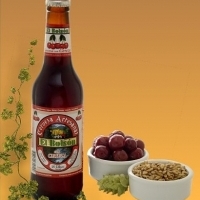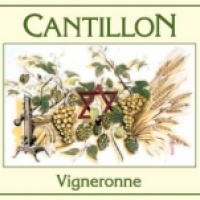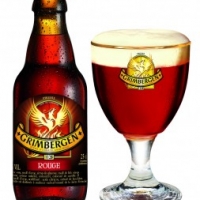Comprar El Bolsón Cerezas - Cantillon Vigneronne - Grimbergen Rouge
Frutada
Ingredientes: Agua - Malta - Cerezas - Lúpulo - Levaduras
Descripción: Elaboradas a partir de mostos fermentados con cerezas, combina el sabor de una excelente cerveza con el dulzor de la fruta.
Temp. de consumo: 0 a 4 º C
Maridaje: Trago largo y postres.
Presentación: Botellas 330 y 750 cc. y Barriles 17, 30 y 50 lts.
The lambic brewers weren't only established in the Senne valley, but also in the valley of the Yssche . This small river has its spring in the Forêt de Soignes and flows through villages like Hoeilaart, Overijse and Huldenberg. In this valley there used to live many brewers who made delicious lambic.
They didn't add cherries or raspberries to their beer, but grapes which had been cultivated in greenhouses. By blending muscat grapes and lambic, the brewers and beer merchants produced the "druivenlambik" (grapes lambic).
In 1973, Jean-Pierre Van Roy, after having relaunched successfully the production of raspberry lambic, bought white grapes and soaked them in lambic. This experiment was successful too. The fructose, which abounds in these fruits, enables us to make a beer which is more mellow than the Gueuze or the other fruit beers.
The name Vigneronne Cantillon was given in 1987. This name reminds us that, while it belongs to the beer patrimony, the spontaneous fermentation, the ageing in the barrels for several years and the addition of grapes make it a distant cousin of certain white wines.
In spite of its success, the Vigneronne represents less than 5% of the total production of the Cantillon brewery. In order to obtain grapes which are as mature as possible, we buy them at the end of the season. Every year, 1000 kilos of white italian grapes are delivered at the Cantillon brewery in the beginning of October.
It is difficult to produce more Vigneronne even though the demand exists. All the grapes are picked from the bunch by hand and we don't have much time, since the new brewing season starts at the end of October.
The beers are not blended before the bottling. The second fermentation is caused by the addition of a sugared liquor. The six-pointed star on our label is an alchemist's symbol. It contains four elements, represented by triangles, of the brewing process. The fire is the symbol of the mashing tun, the earth of the cereals, the air of the yeasts, and the water is the fourth element. At this moment, only a brewer of traditional lambic may use this symbol.
Grimbergen Rouge
As beer was one of the main medieval drinks and brewed the whole year round, the Grimbergen Fathers liked to experiment.
They used red fruit from their surroundings, creating their famous Grimbergen Rouge: a well-balanced beer, brewed in the tradition of Belgian fruity beers, that unites complex red fruit and strawberry aromas with flavours of clove and a hint of spiciness. The bittersweet fruity taste, the rich, dense and pink foam, the ruby colour and the intense fragrances make it a refreshing masterpiece.
--------------------------------
La cerveza era una de las principales bebidas medievales, se elaboraba durante todo el año y a los Padres Grimbergen le gusta experimentar.
Utilizaron fruta roja de su entorno para la creación de su famoso Grimbergen Rouge: Una cerveza bien equilibrada, elaborada en la tradición de cervezas afrutadas belgas, que une a las frutas y fresas complejos aromas rojos con sabores de clavo de olor y un toque de picante.
Gusto afrutado agridulce, espuma rica, densa y de color rosa, color rubí e intensas fragancias hacen de esta cerveza una refrescante obra maestra.
- St. Bernardus Abt 12 - Engelszell Gregorius Trappistenbier - Juguetes Perdidos Strong Dark Belgian Ale Cognac Barrel
- Corona Light - Club Colombia Dorada
- Cerveza Aguila - Panama Light
- Estrella Galicia Especial - Mahou Cinco Estrellas - La Sagra Premium Lager - Bohemia
- Estrella Damm - Heineken - Moritz
- Riu Rau - Tyris Diablos Joe! - Tyris Lalola
- Alhambra Especial - San Miguel Fresca - Cruzcampo Fresca
- Estrella Galicia 1906 Red Vintage - Ambar Export - Amstel Oro
- Dos Equis (XX) Lager Especial - Dos Equis (XX) Ambar - Tecate Light
- Mikkeller Black Hole - Biribil Olentzero - Kees Barrel Project #05/2016
- Blacklab Wheat Love - Galana N. 12 - Birra & Blues Barón Rojo
- Negra Modelo - Modelo Especial - Noche Buena
- Chela Libre Glu Demon - Matoll La Terrasseta - Lagunitas Little Sumpin’ Sumpin’ Ale
- Bush Blond - Bush Pêche Mel
- Furstenberg Festbier - Amstel - Domus Toledo Lager
- Victoria - Grupo Modelo - Indio - Minerva Stout
- Kopparberg Strawberry And Lime - Kopparberg Mixed Fruit - Kopparberg Pear
- Corona Extra - Desperados Original - Cubanisto
- Palm Royale - Happy Fucking Bloody Saison - Baltika 4 Original
- Oettinger Pils - Oettinger Export
- Budweiser - Mythos - Amstel
- Gruut Bruin - Gruut Blond - Gruut Amber
- Austral Calafate Ale - Kunstmann Torobayo - Kross Golden
- Kunstmann Torobayo - Austral Calafate Ale
- Catalan Brewery Mané Galinha - Bonvivant Kraken - La Coruja Rubia
- Stone Go To IPA - Mikkeller San Diego Beer Geek Brunch - AleSmith / Stone Gregarious Nature
- Estrella Damm - Heineken - San Miguel 1516
- Cruzcampo Cruzial
- Lluna Happy Flower - Mitja Galta Hombre de Hielo - BBB - Benidorm’s Blue Beer
- Samuel Adams Octoberfest - Samuel Adams Boston Lager - Samuel Adams Cherry Wheat
- Adriaen Brouwer Dark Gold - Roman Lager 5.0 - Roman Blond 6.5
- Nómada Papaya Crash - Nómada Papaya Rye
- La Petra La Cabaña de Valerio - Urnach Blat
- Witek Santa Vaca IPA - Dunham Cyclope Epsilon IPA - La Virgen Buena Esperanza
- Brewdog Trashy Blonde - Brewdog Hardcore IPA - BrewDog / Stone / Magic Rock Magic Stone Dog
- Cerveza Aguila - Victoria - Guatemala - Club Colombia Dorada
- Amai Cruciforme - Mad Brewing Holy Smoke - Península Winter Ale 2108
- Microbombolla Mirela - Calles de Toledo La Casa del Diamantista - The One Blonde Ale
- Tyris Diablos Joe! - Castelló Beer Factory Golden
- 3Monos Monkey Business - Maiku Rush st.Out - Michelada Malinche Fuego
- Estrella Damm - Budweiser
- Samuel Smith Winter Welcome Ale - Samuel Smith India Ale - Wild Beer Zintuki
- Dos Equis (XX) Lager Especial - Club Colombia Dorada
- Modelo Especial - Indio - Tecate
- Cerveza Sol - Libertad American Pale Lager - Wai Tostada Lager
- Cruzcampo Gran Reserva - Ambar Especial
- Blancaneus i els set llúpols - La Trappe Witte Trappist - Candelaria Witbier
- La Quince Vienna Lager - Källa Esencia - La Virgen / Yakka Marcian Pils
- Black Sheep Ale - BrewDog 5AM Saint - O’Hara’s Irish Stout
- Victoria - Grupo Modelo - Straffe Hendrik Heritage
- Keltius In Peccatum Florina - Keltius Los Suaves - Kel´s
- Modelo Especial - Noche Buena
- De Molen Dag & Dauw - La Trappe Isid’or - De Molen / Zombier Nibs & Beans
- Heineken - Warsteiner Alkoholfrei Pilsener - Kronenbourg 1664
- Ballut Infectos Acelerados 2014 - Santa Pau / Lupulina Gimme Hop! - Península Puro Tropikal
- Naparbier Pumpkin Tzar - 5 Titius Anniversary IPA - Naparbier Black Rock
- Tyris Au Yeah! - Freaks Brewing Tropical Explorers - Olas Altas Balam Blonde Ale
- Medalla Light - Presidente
- La Trappe Tripel - San Miguel Manila








